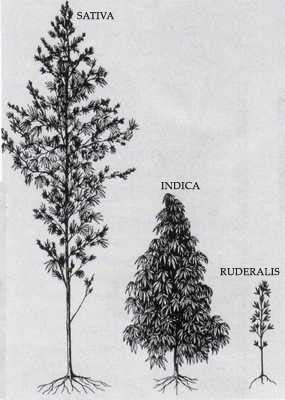What are cannabis strains and what are the differences between the strains?
Amongst recreational growers and users of cannabis, a vernacular
taxonomy, or more accurately, a nomenclature has developed
1 where cannabis varieties are referred to as
strains. Recreational users and medical patients use this system because it is based on the reported, although not scientifically verified physical effects that the strains exhibit. According to this common, but
inaccurate belief, the effects of
sativa strains are described as uplifting and energetic, and are considered more hallucinogenic. In contrast,
indica strains are described as calming and are said to cause relaxation and stress relief.
2 Due to extensive breeding programs, most of the cannabis used medically is a hybrid of sativa and indica varieties.
The cultivars of sativa’s are phenotypically {call-out, text:A phenotype is the observable characteristics of a plant or organism\, for example\, the height or leaf shape} characterized as being tall with widely spaced branches and long thin leaves; they were originally cultivated for the industrial use of fiber, seed oil, and animal feedstuff. In contrast, indica cultivars, originally from Southern Asia, are characterized as shorter bushy plants with broader leaves and have been known to be psychoactive.
1 Some researchers recognize a third cultivar, cannabis ruderalis, which is a smaller, weedy plant originally from Central Russia.
3
Different studies on the genetics and chemotype of cannabis found that the sativa-indica vernacular often has no validity.
4, 5, 6 As pointed out by one of the leading cannabis researchers, Dr. Ethan Russo:
“There are biochemically distinct strains of Cannabis, but the sativa/indica distinction as commonly applied in the lay literature is total nonsense and an exercise in futility. One cannot in any way currently guess the biochemical content of a given Cannabis plant based on its height, branching, or leaf morphology. The degree of interbreeding/hybridization is such that only a biochemical assay tells a potential consumer or scientist what is really in the plant. It is essential that future commerce allows complete and accurate cannabinoid and terpenoid profiles to be available.”6
He further points out that the difference in perceived effects is most likely due to the terpene content. As an example he mentions that the couch-lock effect associated with indica strains are more likely due to the terpene myrcene, while the uplifting mood may be attributed to a high limonene content.
6 These theories, however, have not been verified in clinical studies, although there is one ongoing.
For more info on the different classification schemes used to categorize cannabis, see the section on
Plant varieties.
 Figure 1: The difference in plant size and leaf shape is evident in three cannabis cultivars (image taken from Wikimedia).
Figure 1: The difference in plant size and leaf shape is evident in three cannabis cultivars (image taken from Wikimedia).
- Upton, Roy; Craker, Lyle; ElSohly, Mahmoud; Romm, Aviva; Russo, Ethan; Sexton, Michelle (2013). Cannabis inflorescence : cannabis spp. ; standards of identity, analysis, and quality control (61). American Herbal Pharmacopoeia.
- Pearce, Daniel D.; Mitsouras, Katherine; Irizarry, Kristopher J. (2014). Discriminating the Effects of Cannabis sativa and Cannabis indica: A Web Survey of Medical Cannabis Users. The Journal of Alternative and Complementary Medicine, 20(10), 787--791.
- Erkelens, Jacob L.; Hazekamp, Arno (2014). That which we call Indica, by any other name would smell as sweet. Cannabinoids, 9(1), 9.
- Hazekamp, Arno; Tejkalová, Katerina; Papadimitriou, Stelios (2016). Cannabis: From Cultivar to Chemovar II—A Metabolomics Approach to Cannabis Classification. Cannabis and Cannabinoid Research, 1(1), 202--215.
- McPartland, J. (2015). McPartland's Correct(ed) Vernacular Nomenclature | O'Shaughnessy's. O'Shaughnessy's Online.
- Piomelli, Daniele; Russo, Ethan B. (2016). The Cannabis sativa Versus Cannabis indica Debate: An Interview with Ethan Russo, MD. Cannabis and Cannabinoid Research, 1(1), 44--46.
 Figure 1: The difference in plant size and leaf shape is evident in three cannabis cultivars (image taken from Wikimedia).
References:
Figure 1: The difference in plant size and leaf shape is evident in three cannabis cultivars (image taken from Wikimedia).
References:_logo.svg)